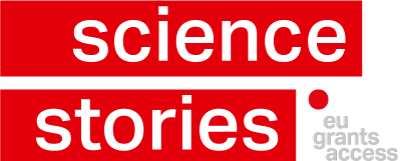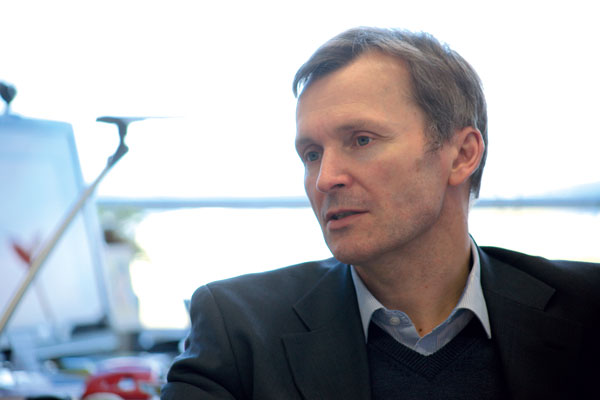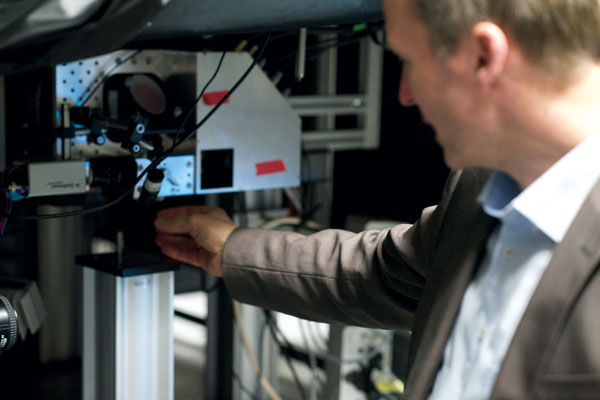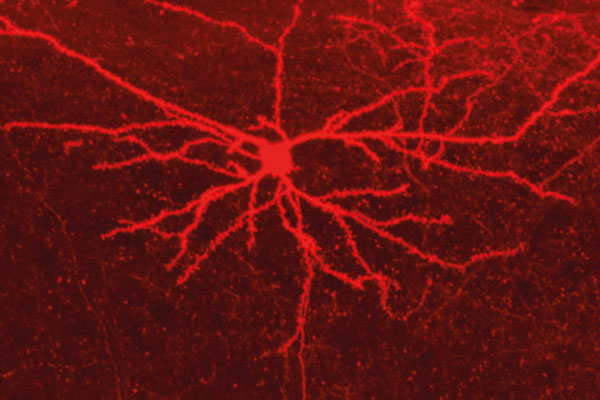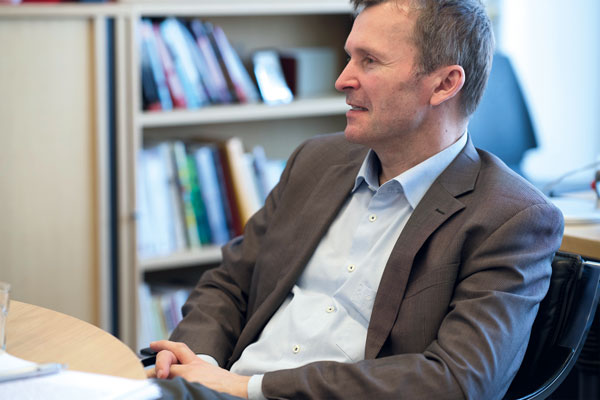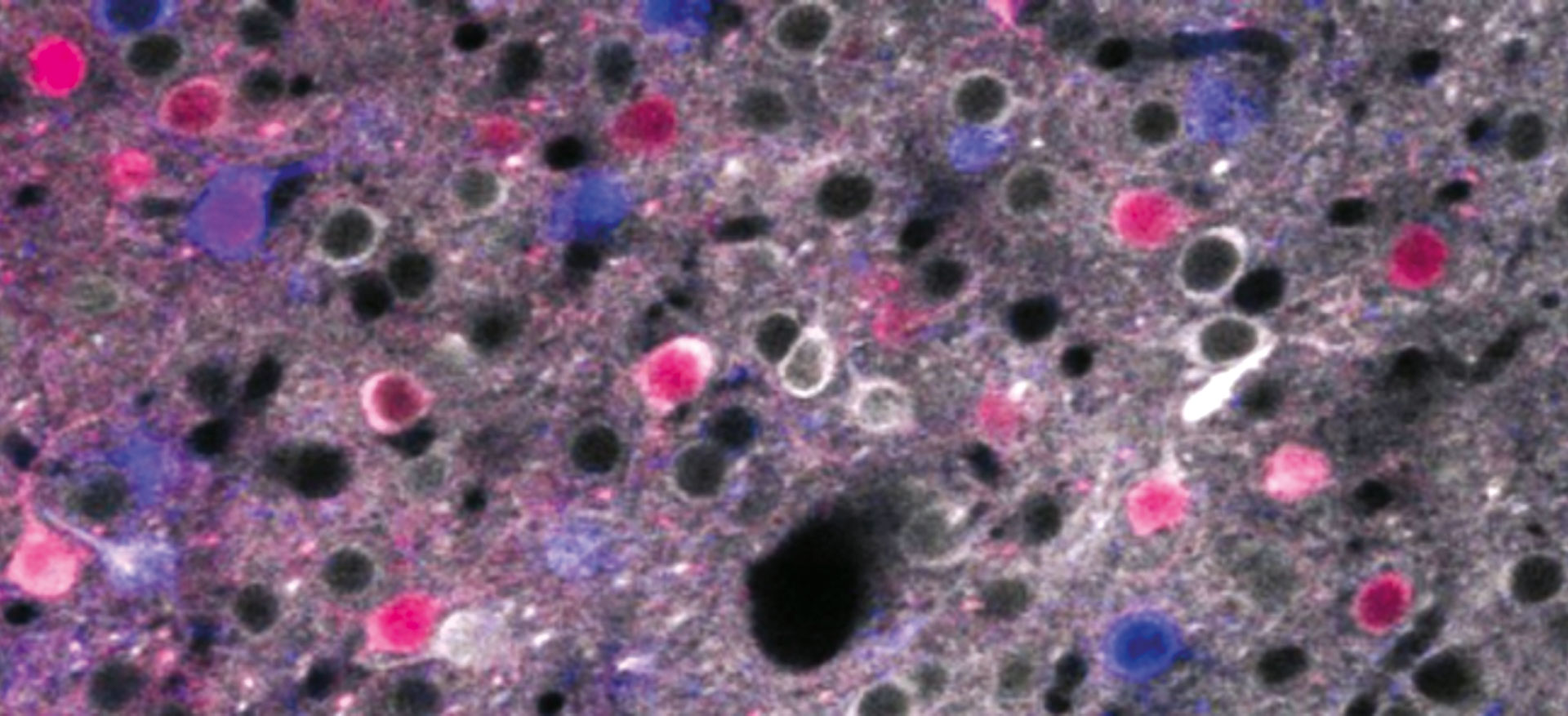
Observing the brain at work
An interview with Fritjof Helmchen, Professor of Neuroscience at the University of Zurich
What Fritjof Helmchen detects when he observes living brains in action, what he dreams of and how he managed to become part of the NIH BRAIN Initiative.
Fritjof Helmchen, how did you become a neuroscientist?
From an early stage, I was fascinated by complex systems and when I got the chance to step into neuroscience looking at the brain as THE most complex system I was just captured. I started as a physics student but very quickly became interested in biophysics and neuroscience. At that time, I also decided to study medicine in parallel to physics. Finally, I got my PhD in physics for neuroscientific work and completed the basic examinations in human medicine as well. I have stayed in neuroscience since then.
You have been in this field for many years. How would you describe the core of your research?
My research over the last 20 years has covered mainly two fields. On one hand, I have focused on the development of new microscopy tools and optical methods to record and visualise the activity of neurons and populations of neurons in the brain under in vivo conditions, i.e. in the living animal. On the other hand, I have been applying these tools to investigate what happens in the brain of a behaving animal, for example when it responds to sensory stimuli. The brain is a device that takes in all the information from the sensory organs and processes them in a suitable way to generate an appropriate behaviour for the interaction with the outside world. This process involves many brain areas, in mammals especially the neocortex. We want to understand how signals flow in the network of brain regions to trigger a specific behaviour. Moreover, we also want to find out what happens during learning when the brain adapts to new situations and the network has to reorganise itself. As a key method, we apply two-photon microscopy, which enables us to watch neurons in vivo while the animal performs its behaviour. In other words, we observe the brain at work.
What is your conclusion from these experiments?
One conclusion is that we see things happening at many places in the brain. Information processing is not merely taking place locally but in a distributed fashion so that many areas of the brain are involved. That is why we want to improve experimental techniques to measure simultaneously from multiple brain areas so that we can begin to understand the rules of how they communicate.
Ultimately, what could be the impact for society of your basic research?
Our basic research first fosters a better understanding of normal signal flow in a healthy brain. On this foundation, it may also help to understand what goes wrong when brain networks are in disorder or affected by a disease. For example, brain damage caused by a trauma, a stroke or a degeneration process will lead to adaptive changes in the signal flow in the remaining part of the brain. And there is the whole spectrum of psychiatric disorders, for which the anatomical changes are less obvious. Here, our basic insights regarding brain signal flow could be valuable in order to identify and characterise misguided signal flow in disordered brains. In the end, we hope that our results will contribute to developing therapies to alleviate or cure human brain diseases.
If you as a researcher could make one dream come true – which one would it be?
I have the dream that the current advances in understanding signal processing in the brain will eventually lead to a brain theory that can be expressed in terms of mathematical equations. This theory of brain dynamics would allow us to describe and reproduce the essentials of signal processing and the generation of adaptive behaviour by the brain.
So once you can describe these essentials mathematically, you would be able to build a brain?
The aim would not be to build or replicate an entire brain, but you could perhaps build a simplified device, which would be able to reproduce certain types of high-level cognitive behaviour.
Based on such a brain theory, could you build a robot able to learn like the brain does?
I think so. We are entering a phase where computer science and machine learning approaches, together with the new insights in neurobiology and brain research, are likely to boost the developments in this direction. In the end, it might lead to new devices, which operate based on insights we gained from neuroscience and computer science. New machine learning approaches have been quite successful for instance in pattern recognition. However, as far as I know, they are such complex artificial networks that even the specialists do not understand what is going on. So even they would like to capture the essence and understand the principles of how their machines’ deep networks really operate. That is a common challenge regarding biological and artificial neuronal networks in the coming years.
Let us talk about research funding. Three years ago, you applied for a grant of the NIH and you got it. Why?
My project financed by the NIH is linked to the US-led BRAIN Initiative that President Obama initiated in 2013. The scope of this initiative is very much aligned with the scope of my own research, which motivated me to apply. The NIH BRAIN Initiative has the same core aspects as my research: pushing forward with neurotechnologies, focusing on the network level and trying to capture the principles of circuit dynamics in the brain. Eventually, the aim is to investigate brain diseases and circuit dysfunctions. So I submitted my application to the NIH as I thought my lab would fit perfectly into their programme and we could benefit from interactions with the US groups. Now we are very happy that for almost three years we have been part of the NIH BRAIN Initiative. Just recently, I applied for an extension of our grant, and I hope very much that it will be approved because we really would like to stay in this programme.
How was your experience with the NIH?
(Laughing) It was very good as we got funded. However, I must admit that at the beginning I did not expect to have a real chance, being a European lab. I was excited when, in the end, several European labs were included in the funding and became part of the BRAIN Initiative.
Apart from the financial aspect, how do you benefit from this NIH grant?
A key benefit is the extra level of scientific networking. Progress in research depends largely on the interactions with other scientists. Ideas are usually not generated when you sit in a quiet room but through discussions with other researchers. So the opportunity to participate in important meetings like the annual conference of the BRAIN Initiative is crucial to catch up with the latest trends in the field and cutting-edge methods. You can then select what you want to use in your own lab and in which direction you want to proceed. That is even more valuable than money.
So would you recommend other researchers to apply for a grant at NIH?
Yes, definitely. Many researchers in Europe do not know that for some of the NIH grants European labs are also eligible. Therefore, I can only encourage people to try.
You have funds from several agencies at your disposal. You received an ERC and SNSF Grant. Do you follow a specific funding strategy?
In addition to the core funding of my university, I was fortunate to be well funded over the years by different funding agencies; first of all by the SNSF, which was very important to me. But another important pillar of finance have been the EU research funds. Before I received the ERC Grant, I participated in several EU research consortia where I got to know many colleagues. I also learnt a lot about other labs and institutions in Europe and could form scientific collaborations. Nevertheless, there is no real strategic concept behind my grant applications beside the research direction and the specific interests at the given moment, which obviously change over the years.
Comparing these funding agencies, what are the main differences?
One of the differences between the several agencies relates to the bureaucratic requirements and administrative burdens associated with them. For me as a researcher this is a crucial point, as time spent on administration matters is time lost doing research. That is why my colleagues and I like lean administration. Unfortunately, the EU research administration is particularly bureaucratic. But also the administrative processes for the NIH grant have been quite complicated. Therefore, a service like that of EU GrantsAccess is of great help. I have to emphasise that for both grant applications, to the NIH and the ERC, the EU GrantsAccess Office was very helpful in setting up and handling the application, supporting us throughout the entire procedure.
Based on your experience, what would you recommend your colleagues regarding funding applications?
First, I would recommend to just ‘try it’, even if it is an effort. Writing an application for a grant is also an opportunity to think about your concept and to put your ideas down on paper. Even if your application is rejected, your effort was not in vain. The work you have done has helped you to refine your research focus and you might use the application for another funding scheme. However, to be successful I also recommend defining your own niche where you have your unique brand of excellence. You know the field, you know the other research groups, you know where your place is in the field and you know the unique expertise of your research team. Build upon these strengths for a grant application and make a strong case for what you can contribute.
Measure neuronal activity in the brain in vivo
The major research interest of Fritjof Helmchen is to reveal fundamental principles of neural circuit function with regard to brain computations and learning by advancing optical methods for studying neuronal network dynamics ‘in vivo’, which means in the living brain at work. For this research, he particularly applies two-photon microscopy, a special fluorescence microscopy technique that allows direct observation of neuronal activity patterns in vivo. A small glass window that replaces a part of the skull of the mouse makes it possible to watch and measure with the microscope what happens in the brain while the mouse follows its normal activities or performs trained behaviours. Fritjof Helmchen’s group has pioneered several two-photon microscopy variants, including 3D and high-speed in vivo two-photon imaging, and has contributed to recent advancements in the study of brain microcircuits.
Interview with Fritjof Helmchen
Fritjof Helmchen
Fritjof Helmchen studied physics and medicine (preclinical part) at the University of Heidelberg and received his PhD in physics at the University of Göttingen for work carried out at the Max Planck Institute for Medical Research in Heidelberg. During his postdoctoral period at the Biological Computation Research Department at Bell Laboratories in New Jersey, USA, he helped to establish two-photon microscopy as a novel technology that enables measurements of neuronal activity in the brain in vivo. After his return to Europe, he applied and refined this technology when he led a junior group at the Max Planck Institute in Heidelberg. In 2005, Fritjof Helmchen was appointed Associate Professor of Neurophysiology and Co-Director of the Brain Research Institute at the University of Zurich. Since 2013, he is Full Professor of Neuroscience. He currently acts as Director of the Neuroscience Center Zurich.
Major grants received by Fritjof Helmchen, currently running
BRAIN Initiative, National Institutes of Health (NIH) 2014-2017, CHF 725,000
“Multi-area two-photon microscopy for revealing long-distance
communication between multiple local brain circuits”
https://www.nih.gov/
Swiss National Science Foundation (SNSF) 2017-2020, CHF 746,000
„Inter-areal Neocortical Dynamics during Mouse Behaviour“
http://www.snf.ch/en/Pages/default.aspx
HORIZON 2020 ERC Advanced Grant 2016-2021, CHF 2,500,000
“BRAINCOMPATH: Mesoscale Brain Dynamics: Computing with Neuronal Pathways”
https://erc.europa.eu/funding/advanced-grants
